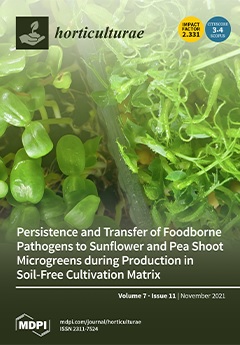Ver ítem
- xmlui.general.dspace_homeCentros Regionales y EEAsCentro Regional Tucumán - Santiago del EsteroEEA FamailláArtículos científicosxmlui.ArtifactBrowser.ItemViewer.trail
- Inicio
- Centros Regionales y EEAs
- Centro Regional Tucumán - Santiago del Estero
- EEA Famaillá
- Artículos científicos
- Ver ítem
Potential Bacterial Antagonists for the Control of Charcoal Rot (Macrophomina phaseolina) in Strawberry
Resumen
The effect of antagonistic bacteria to control Macrophomina phaseolina was evaluated under in vitro, growth chamber, greenhouse and field conditions. A total of 177 bacteria, isolated from Athrocaulon macrostachyum rhizosphere of the Lebrija marsh, were screened for their potential against M. phaseolina (causes charcoal rot in strawberry) by dual culture assay. Of these isolates, 14 most promising strains were molecularly identified by the 16S rDNA
[ver mas...]
The effect of antagonistic bacteria to control Macrophomina phaseolina was evaluated under in vitro, growth chamber, greenhouse and field conditions. A total of 177 bacteria, isolated from Athrocaulon macrostachyum rhizosphere of the Lebrija marsh, were screened for their potential against M. phaseolina (causes charcoal rot in strawberry) by dual culture assay. Of these isolates, 14 most promising strains were molecularly identified by the 16S rDNA sequencing method using the EzBioCloud database. These strains were tested for in vitro hydrolytic enzymes, HCN production, and biocontrol against M. phaseolina in strawberry plants. All the 14 strains produced, at least, one hydrolytic enzymatic activity and one of them, which belongs to Brevibacterium genus (Hvs8), showed the lowest records of disease incidence (20%) and severity (0.4). With these results, greenhouse and field trials were carried out with the Hvs8 strain, compared to non-treated control. In the greenhouse assays, Hvs8 strain increased root dry mass by 30%, over the control. In the field trials, production and fruit quality were not significantly different between Hvs8 treatment and non-treated control, but plant mortality and plant mortality associated to M. phaseolina decreased by more than 24% and 65% respectively, in Hvs8 treatment. This study suggests that Brevibacterium sp. Hvs8 strain could be a candidate for controlling charcoal rot in strawberry.
[Cerrar]

Autor
Viejobueno, Josefina;
Rodríguez-Berbel, Natalia;
Miranda, Luis;
Santos, Berta de los;
Camacho, María;
Fuente
Horticulturae 7 (11) : 457. (November 2021)
Fecha
2021-11
Editorial
MDPI
ISSN
2311-7524
Formato
pdf
Tipo de documento
artículo
Palabras Claves
Derechos de acceso
Abierto
 Excepto donde se diga explicitamente, este item se publica bajo la siguiente descripción: Creative Commons Attribution-NonCommercial-ShareAlike 2.5 Unported (CC BY-NC-SA 2.5)
Excepto donde se diga explicitamente, este item se publica bajo la siguiente descripción: Creative Commons Attribution-NonCommercial-ShareAlike 2.5 Unported (CC BY-NC-SA 2.5)
Metadatos
Mostrar el registro completo del ítem
Excepto si se señala otra cosa, la licencia del ítem se describe como info:eu-repo/semantics/openAccess
Ítems relacionados
Mostrando ítems relacionados por Título, autor o materia.
-
Manejo de malezas en el cultivo de pecán
Taiariol, Dario (EEA Bella Vista, INTA, 2022-12-15)Una planta no deseada en un lugar no deseado. No siempre invasivas o salvajes. Efectos adversos de malezas. -En plantas jóvenes: Compite y afecta la disponibilidad de nutrientes, luz y agua y, además, alelopatías. - En ... -
Taladrillo de los forestales: algunos aspectos de su biología, detección y manejo de poblaciones
Cichon, Liliana; Garrido, Silvina Alejandra; Lago, Jonatan; Ahmad, Samir (EEA Alto Valle, INTA, 2013)Megaplatypus sulcatus Chapius, conocido vulgarmente como "barreno" o "taladrillo de los forestales", es un coleóptero que produce severos daños en plantaciones forestales y frutales perforando el tronco de los árboles, ... -
Insectos de importancia económica y sanitaria La chinche del arce, Boisea trivittata: una nueva especie establecida en la Patagonia
D’Hervé, Federico; Fernández, Celeste (EEA Bariloche, INTA, 2025-07)La chinche del arce, una especie exótica originaria de América del Norte, ha sido detectada recientemente en el norte de Neuquén. Este insecto se alimenta principalmente de las semillas del arce, un árbol ornamental frecuente ...


